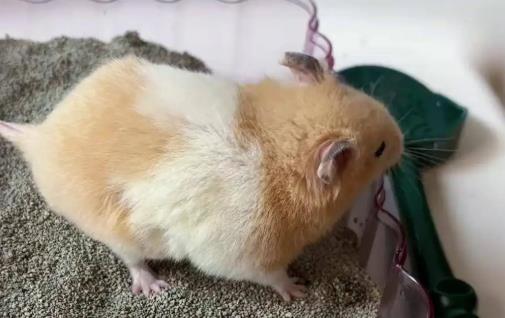Hamsters are highly sensitive to temperature changes, and their living temperature must be strictly controlled within a suitable range—otherwise, it may cause health issues or even death. Below is a detailed explanation and practical advice on hamster survival temperatures:

I. Suitable Survival Temperature Range
The most comfortable temperature range for hamsters is 68°F–82.4°F (20°C–28°C), with specific breakdowns as follows:
1. Optimal Activity Temperature: 71.6°F–78.8°F (22°C–26°C)
Within this range, hamsters are highly active, have a strong appetite, and maintain normal metabolism—making it ideal for interaction and playtime.
2. Tolerable Range: 59°F–86°F (15°C–30°C)
Hamsters can temporarily adapt to these critical temperatures through behavioral adjustments (e.g., curling up for warmth or increasing water intake). However, long-term exposure to this range may harm their health.
II. Risks of Extreme Temperatures & Responses
1. Low-Temperature Risks (<59°F / 15°C)
Symptoms: Decreased activity, huddling in a ball, shivering, loss of appetite. In severe cases, hamsters may enter a pseudo-hibernation state (sudden drop in body temperature, weak breathing, stiff limbs).
Dangers: Untreated pseudo-hibernation can lead to organ failure and death. Roborovski Dwarf Hamsters (often called "Robos") are particularly sensitive to low temperatures.
Response Measures:
Winter Warmth: Use a ceramic heat lamp (placed away from the cage to prevent burns) or a pet-specific heating pad (positioned under the outer side of the cage floor).
Bedding Adjustments: Add extra (degreased cotton), paper-based bedding, or dust-free wood shavings—aim for a thickness of at least 2 inches (5cm) to create a warm nest.
Environment Sealing: Move the cage to a warm indoor area, avoiding drafty spots (e.g., near vents, doors, windows, or balconies).
Pseudo-Hibernation First Aid: If pseudo-hibernation is detected, immediately warm the hamster by holding it in your palms. Feed it warm glucose water (dabbed onto its mouth with a cotton swab). After slow recovery, provide a warm environment for rest.
2. High-Temperature Risks (>86°F / 30°C)
Symptoms: Rapid breathing, panting with an open mouth, excessive drinking, lethargy. In severe cases, heatstroke may occur (twitching, unconsciousness).
Dangers: Heatstroke can cause brain edema or organ damage, with a very high mortality rate. Syrian Hamsters (Golden Hamsters) are more sensitive to high temperatures.
Response Measures:
Summer Cooling: Place a marble slab, ceramic hideout, or cooling pad in the cage for the hamster to lie on.
Ventilation Optimization: Use a small fan (avoid direct blowing) or improve air circulation around the cage to prevent a stuffy, overheated environment.
Cooling Foods: Offer small amounts of watermelon rind (without the red flesh) or cucumber slices to 补充水分 (replenish moisture), but control portions to avoid diarrhea.
Heatstroke First Aid: Wrap the hamster in a damp towel and place it in an air-conditioned room (around 77°F / 25°C). Provide electrolyte water (e.g., diluted pet-specific electrolytes). After recovery, offer a quiet environment for rest.
III. Temperature Tolerance Traits by Breed
Campbell’s Dwarf Hamster: Moderate cold tolerance (needs thicker bedding in winter); average heat tolerance (avoid stuffiness in summer).
Pudding Hamster: Delicate constitution—temperature fluctuations easily trigger pseudo-hibernation, requiring strict temperature control.
Syrian Hamster (Golden Hamster): Low heat tolerance (needs enhanced cooling in summer); better cold tolerance, but still requires warmth in winter.
Winter White Dwarf Hamster (Silver Fox Hamster): High risk of pseudo-hibernation—closely monitor behavior in low-temperature environments.
Roborovski Dwarf Hamster: Strong heat tolerance but extremely poor cold tolerance; strict winter temperature control is required (no lower than 64.4°F / 18°C).
IV. Practical Tips for Temperature Control
Use a Thermometer: Place a digital thermometer inside the cage to monitor the environment temperature in real time and ensure it stays within the safe range.
Observe Behavioral Changes: If the hamster frequently curls up, loses appetite sharply, or breathes rapidly, immediately check the temperature and make adjustments.
Avoid Sudden Temperature Shifts: Do not move the cage abruptly from a hot environment to a cold one (e.g., an air-conditioned room) or vice versa, as this may cause stress.
Regular Cage Cleaning: In high temperatures, hamster waste easily breeds bacteria—increase cleaning frequency to keep the cage dry and hygienic.
V. Common Misconceptions Clarified
Misconception 1: "Hamsters have thick fur, so they’re not afraid of the cold."Fact: Although hamsters have dense fur, they have a large surface area relative to their body size, leading to rapid heat loss. They are prone to hypothermia in low temperatures, especially baby hamsters and elderly hamsters.
Misconception 2: "Just turning on the air conditioner in summer is enough."Fact: In air-conditioned rooms, avoid direct airflow on the cage, and do not set the temperature below 71.6°F (22°C)—otherwise, it may cause colds or joint problems.
Misconception 3: "Heating pads can be placed directly inside the cage."Fact: Heating pads must be used under the cage floor (not inside) to prevent the hamster from chewing the wires or getting burned by localized overheating.
VI. Seasonal Temperature Management Key Points
Spring: Large day-night temperature differences—ensure nighttime warmth to avoid pseudo-hibernation caused by "late spring cold snaps."
Summer: High temperature and humidity—strengthen ventilation and cooling, and prevent intestinal diseases from spoiled food.
Autumn: Temperatures gradually drop—prepare warm supplies in advance (e.g., degreased cotton, heating pads).
Winter: Low temperature and dryness—increase bedding thickness, provide warm drinking water (around 77°F / 25°C), and prevent water from freezing.
